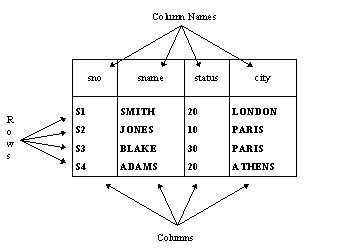





In the relational model, data are logically presented in two dimensional tables made up of rows and columns, as shown in the figure below. The intersection of a row and a column is known as a field. Fields contain individual data items called field values. The rows of a table, also known as records, are made up of a sequence of values that describes an occurrence of an entity (for example, a set of values that describes a particular employee). The columns of a table consist of a collection of attributes, which are characteristics of an entity. For example, each employee has an employee ID and a name.
When creating database objects, you must follow certain conventions. For example, every table must have a unique name, and within a table, every column must have a unique column name and a data type. When you ask the XDB Server to retrieve or modify data, it performs the job on the set of rows and columns you specify. An action may affect rows, columns or fields.

There exists no universally accepted standard for database terminology. Throughout this reference and other XDB Server documentation, we use a number of relational terms that have specific meanings that may differ from normal usage.


